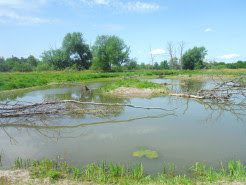Kanata wetland project reclaims wildlife
KANATA NORTH — You know what they say: ‘If you build it, they will come.’ But that old adage isn’t just for haunted baseball fields – it also applies to wetland projects right in the heart of Ottawa’s greenbelt.
Last fall, staff at the RVCA and the National Capital Commission created 10,000 square metres of new wetland habitat along Stillwater Creek, just south of the new DND headquarters off Moodie Drive and Highway 417.

Thanks to observations from the Ottawa-Carleton Wildlife Centre, which is located nearby, staff at the NCC and RVCA discovered the wetland had been suffering annually from extreme low water conditions. Most of the year the wetland was completely dry, dominated by long, reedy grasses that don’t encourage much biodiversity.
Now, the restored wetland areas have been reconnected to the groundwater system and feature three large, permanent ponds of varying depths, with logs and branches for fish and wildlife habitat and a range of native wetland plants.
“The transformation has been nothing short of miraculous: in just one season, RVCA biologists and field staff have witnessed a huge comeback for frogs, birds and fish,” the RVCA said.
Staff have spied a spotted sandpiper, nesting killdeer and a yellow warbler. Frogs have moved in and will likely stay the winter. And they’ve found a wide variety of fish in the new habitat, including pearl dace, brown bullhead and blacknose shiners.
“This project was about improving the hydrology and the function of the wetland, but when you do that the ecological functions inevitably improve, too,” said RVCA aquatic biologist Jennifer Lamoureux, who designed the wetland features.
The work isn’t quite finished. This fall, staff and volunteers will harvest cuttings from nearby dogwood and willow shrubs and will stake them around the wetlands to encourage growth of the plants, which will provide shade and important shoreline habitat.
Funding permitting, staff hope to continue monitoring the health of the new wetland over the next five years as plants take root and more wildlife begins to call it home.
Residents can watch the progress for themselves: walking trails are already present all around the wetland, connecting to the Watts Creek pathway off Corkstown Road.



